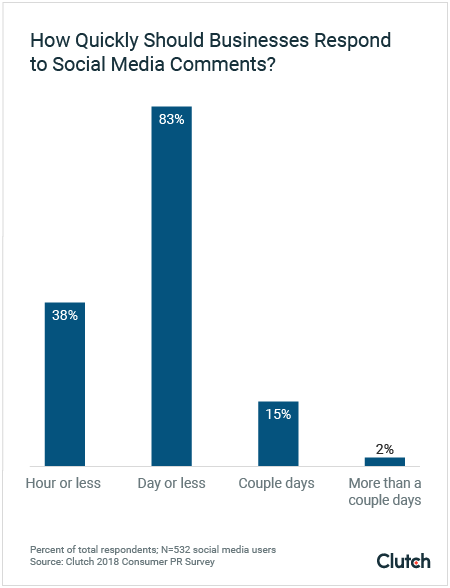One of the most reliable PR strategies relies on happy customers telling those in their communities. From this ‘word of mouth,’ businesses can grow their consumer base.
The social brain hypothesis quantifies the concept of community from a scientific standpoint. According to this hypothesis, the average person can only maintain around 150 stable relationships and the largest ‘circle’ of community (called the ‘tribe’ in the hypothesis) maxes out at 2,000 people.

From a PR perspective, this places limits on the ‘word of mouth’ tactic, however, social media has expanded the concept of community to include many more people and has changed how people communicate.
This presents businesses with more opportunities to reach more people, but also comes with risks. Luckily, with the right approach, these risks are manageable and can present a company with opportunities to elevate their brand.
Time Is a Restraint
Before social media, companies had time to strategize before responding to consumers’ complaints and criticisms. Social media broke down traditional barriers that stood between consumers and companies. Now, consumers can voice complaints instantly on social media and be instantly heard by consumers around the world.
This makes time an ultimate restraint. Companies need to respond to comments quickly to prevent these comments from going viral and to maintain control over the situation.
A recent survey showed that most people (76%) expect companies to respond to comments (positive and/or negative) about their brand on social media and 83% expect companies to respond within a day or less.
Social media gives consumers a platform to instantly voice their concerns and businesses are expected to respond and should respond quickly to get ahead of any potential crises.
Acknowledge Your Faults
Other than the Better Business Bureau (BBB), there were few institutions in place that held businesses accountable before social media. Traditionally, businesses would promote advertisements and marketing materials that showed their products and services in the best light possible.
Through social media, however, consumers can provide genuine reviews on businesses based on their own experiences in real-time. This provides other customers with an authentic depiction of the business and its products and/or services.
While this is a great opportunity to attract new customers, it also means that criticism and bad reviews are unavoidable. The worst thing a company can do is ignore these negative comments.
People expect businesses to respond to criticism and responding to negative comments on social media can help elevate a company’s brand.
Forty-five percent (45%) of people say they would view a company more positively if it responded to negative comments on social media and 72% say they would recommend a company based on a positive social media interaction with that company.
This is great news for businesses; with social media consumers’ communities are bigger and their ‘word of mouth’ recommendations can now extend beyond traditional boundaries. The bad news is that criticism is inevitable, however, no one expects perfection from companies.
While consumers don’t expect a 5-star world, they do expect to be acknowledged. When companies respond to negative comments, they show they care about their consumers and are constantly improving the shopping experience for their customers.
Treat Social Media Interactions the Same as In-Person Ones
A company’s social media presence is valued by consumers and reflects the culture of the brand.
Active listening and consistency are two elements businesses should bring to their social media interactions. Businesses that are listening and reacting authentically to people’s concerns will make them feel safe buying from them and more inclined to recommend the business to others.
As more people use social media and rely on it as a source of community, these interactions will only become more relevant in consumers’ buying choices, especially as younger generations gain more purchasing power.


